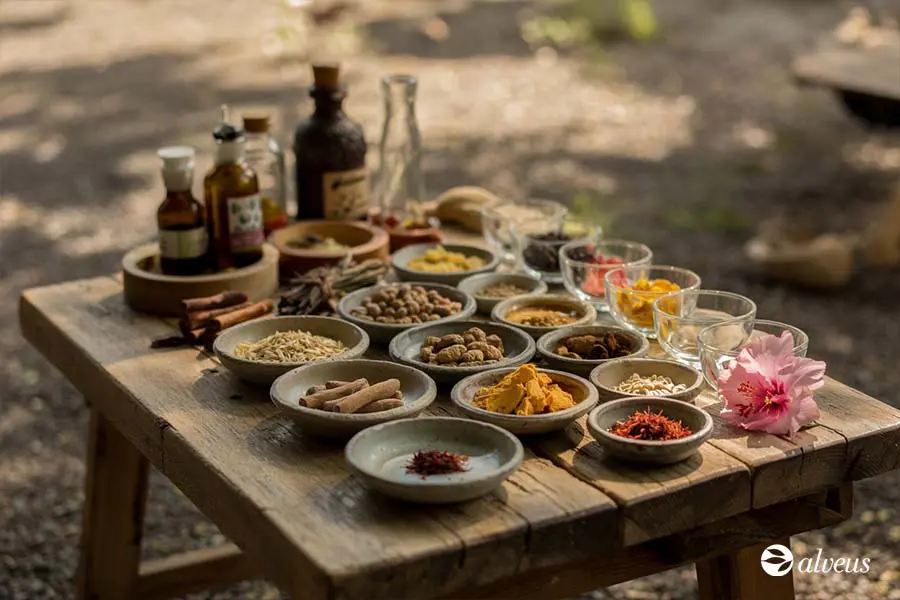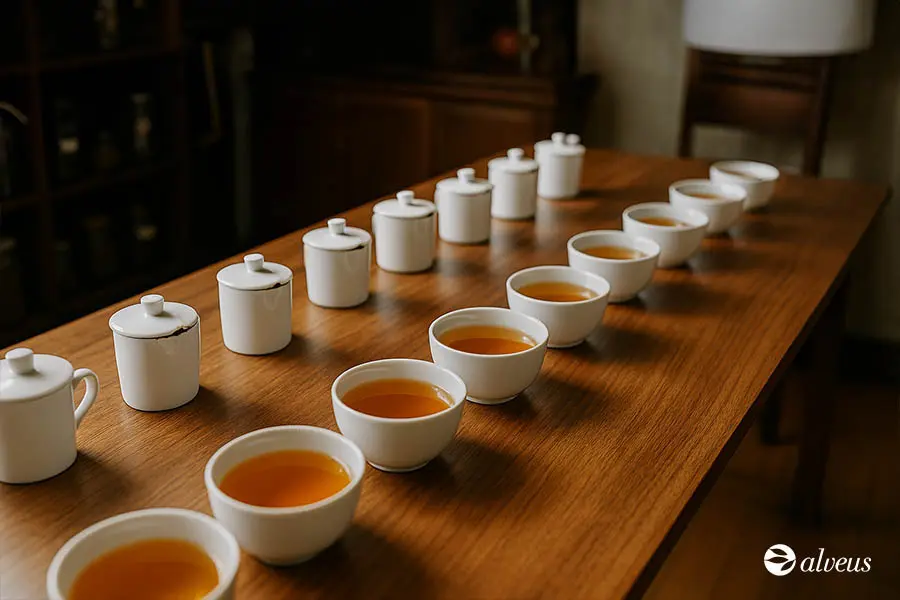The medicinal plants of India and the Middle East have a millennia-old tradition, having been a therapeutic resource and a fundamental pillar in the development of sophisticated medical systems.
These traditions, particularly Indian Ayurvedic medicine and Unani Tibb in the Arab world, have shaped how societies understand health and the balance between body and mind.
Over the centuries, these practices have evolved, and today they remain relevant, supported by scientific studies that validate their effectiveness and encourage their integration into modern medicine.
In this article, we will explore the history, philosophy, and contemporary impact of these ancient medicinal herbs, focusing on the most important plants and their relevance today.
Origins and Evolution of Ancient Medical Systems
The rich cultural and geographical diversity of India has been the birthplace of traditional medical systems that have profoundly influenced the understanding of health and well-being.
Two of the most prominent are Ayurveda and Unani Tibb, both deeply rooted in the use of indigenous medicinal herbs.
In India, Vedic texts like the Atharvaveda (1200 BCE) already made references to medicinal herbs, while foundational texts like the Charaka Samhita and Sushruta Samhita (6th century BCE) consolidated the principles of Ayurveda.
Meanwhile, Unani Tibb evolved from the Greek medicine of Hippocrates and Galen, enriched by contributions from Persian and Arab physicians such as Avicenna and Al-Razi.
With the arrival of Islam in India in the 13th century, Unani Tibb merged with local traditions, creating a synergy between the two medical systems. During the Mughal rule, Unani medicine flourished further, with hospitals and medical schools dedicated to its teaching.
What is Indian Ayurvedic Medicine?
Ayurveda, which means “science of life” in Sanskrit, is one of the oldest medical systems in the world, with over 5,000 years of history. Originating in the Indian subcontinent, Ayurvedic medicine is based on a holistic approach that seeks harmony between body, mind, and spirit.
Its philosophy asserts that health depends on the balance of the three doshas, which represent combinations of the five fundamental elements (ether, air, fire, water, and earth):
- Vata (air and ether): Regulates movement and vital energy.
- Pitta (fire and water): Related to metabolism and digestion.
- Kapha (water and earth): Associated with stability and bodily structure.

Medicinal Herbs in Ayurveda
To maintain this balance, Ayurveda employs herbs, minerals, and metals with therapeutic properties. Some of the most commonly used medicinal plants include:
- Turmeric: This root, commonly found in India, is known for its anti-inflammatory and antioxidant properties. Its potential for improving digestive and skin health has also been explored.
- Neem: Known for its antibacterial, antifungal, and blood-purifying properties.
- Tulsi: Revered in Indian culture, this plant is used in Ayurveda to balance doshas, particularly Kapha and Pitta. It is attributed with adaptogenic and antioxidant properties.
- Amla: A fruit known for its high vitamin C and antioxidant content. It is traditionally used for skin, hair, and digestion.
- Ashwagandha: Traditionally used in Ayurvedic medicine in contexts related to stress management and overall well-being. Its potential impact on energy and the nervous system has been studied.
Moringa: Considered a superfood, rich in vitamins and minerals. Studies have examined its potential to influence blood sugar levels and lipid profiles.
Ayurvedic Rituals and Their Connection to Health
Ayurveda is based on the prescription of herbs and integrates a series of daily Ayurvedic rituals (Dinacharya) designed to balance the body and mind.
Some of the most commonly practiced include:
- Ubtan: Use of herbs and spices like turmeric in facial masks and natural exfoliants.
- Digestive practices: Drinking warm water on an empty stomach and consuming spices like ginger and cumin to enhance digestion.
- Jala Neti: Nasal cleansing with saline water to improve breathing and prevent infections.
- Abhyanga: Massaging with herbal oils, which, according to Ayurvedic tradition, has been used for skin care and relaxation.
- Rasayana: The use of herbal tonics like amla and ashwagandha in Ayurveda, considered a traditional practice related to wellness and longevity.

Unani Tibb: Arab Medicine in India
Unani Tibb, also known as Unani medicine, is a traditional medical system based on the theory of the four humours (blood, yellow bile, black bile, and phlegm), with roots in the Greek medicine of Hippocrates and Galen.
This theory holds that health depends on the balance between these bodily fluids, and any imbalance may cause diseases, which are treated through dietary adjustments, herbs, and other natural methods.
Over the centuries, this tradition was enriched by Arab and Persian physicians and, through trade and cultural routes, reached India in the 13th century. There, Unani Tibb integrated with local practices, giving rise to a unique approach to health and disease treatment.
Some of the most commonly used plants in Unani medicine include:
- Fennel: Traditionally used to aid digestion and relieve stomach spasms.
- Liquorice: Commonly used as a soothing agent for the respiratory and digestive tract.
- Saffron: Valued for its antioxidant potential and mood-enhancing effects.
- Hibiscus: Historically associated with regulating blood pressure and protecting cardiovascular health.
- Myrrrh: Commonly used in traditional preparations, with uses related to skin care and emotional well-being.
This medical system remains relevant today, especially in India and the Middle East, where it continues to be a natural and complementary alternative to modern medicine.

Impact of Indian Medicinal Plants on Modern Science
In recent decades, there has been a resurgence of interest in Indian Ayurvedic medicine and Unani Tibb, driving their integration into modern health systems.
The World Health Organization (WHO) recognises their importance and has established research centres to scientifically validate the benefits of these medicines, which utilise medicinal plants from India and the Middle East.
Scientific studies have investigated the efficacy of many medicinal plants used in Ayurveda and Unani, such as turmeric and neem, whose compounds have shown potential therapeutic properties.
Some of these herbs have been incorporated into supplements and wellness practices in modern medicine. One example is ashwagandha, which has been studied for its potential impact on stress and anxiety.
Moreover, with the increasing demand for natural remedies, it is essential to ensure their sustainable production to preserve this ancestral knowledge and guarantee future generations’ access.
Relevance of Indian Medicinal Herbs Today
The use of medicinal plants from India and the Middle East in medical systems like Ayurveda and Unani Tibb has endured for millennia due to their holistic approach and deep connection to nature.
Today, interest in these disciplines has resurfaced, supported by scientific studies and the growing demand for natural alternatives in health care. However, their integration into modern medicine requires a balance between preserving ancient knowledge and scientifically validating their benefits.
As we move towards a more holistic view of well-being, Ayurveda and Unani, with their use of medicinal herbs, continue to play an essential role in health care and disease prevention, reminding us of the importance of harmonising body, mind, and environment.










